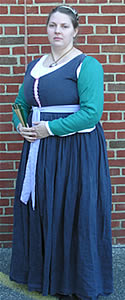
Dated 1460 to 1485
Why?I wanted a last minute dress for Twelfth Night one year when I was relatively new to the SCA. I received help and a basic pattern for the bodice of this gown, and it was so simple how could I not do it? Since then I have become enamored of this style and wanted to research it, to really peg it down. (I actually heard one teacher of an Italian Renaissance garb class say that they have never seen a front laced Italian Ren gown. Thus the mission was born.)
I started researching this gown and finding as many depictions of it in contemporary art of the period. The first painting I saw that clearly showed this style was a detail of the Allegory of March: Triumph of Minerva showing the spinners and weavers from the upper right hand corner. This painting offered many different views of the gown in question and almost all of the ladies in the picture are wearing a version of this gown.
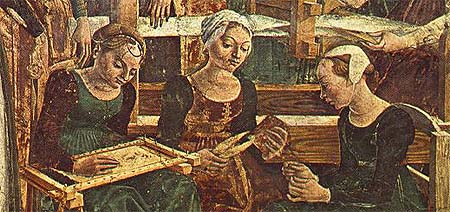
The gown is commonly seen on middle class women, but some upper class women have been shown wearing a version of it as well. The few upper class pictures of this gown are earlier and the paintings of middle class women wearing it are later. The ladies shown wearing this gown range from the Madonna, saints and allegorical figures to spinners, weavers, attendants, dancers and revelers. The gown is well suited to middle class or working class wear as it is very comfortable and does not contain the common ostentatious decorations seen on gowns of the nobility. The sleeves are closed so as to not get in the way of work, but loose at the shoulders to give ease of movement and shoulder rotation. The bodice is often unadorned, close fitting, but not corseted or laced in too tightly. The skirts are full and luxurious, but not long enough to be in the way and underfoot.
The typical gown appeared to be laced up the front through lacing holes or rings. The gown has the high waistline typically seen throughout the Italian Renaissance, but less directly under the bust, and more at the line of the last rib. The skirt was pleated on in a variety of methods from box pleats to cartridge pleats. In most depictions, the dresses have sleeves that appear to be sewn onto the gown, but could have been closely laced. The sleeves were often shown in different colors from the bodice and skirt. The sleeves are rather roomy in the shoulder, unlike cotehardie sleeves, and occasionally pleated or gathered at the shoulder seam. The forearm seams are left open and closed at one or two points with either lacing or widely set buttons.
My best guess is that this gown is Florentine, or seen in paintings by artists from Florence, or on frescos in Florence. It is very unlike the classic Venetian style that had a higher waist and more sloping shoulders. From my poor memory of my medieval history class, I believe that Florence was primarily a merchant crossroads area. Situated in the mountains that run lengthwise down the Italian peninsula, it was one of the few major cities that was not a seaport. The longer and solid sleeves and the bodices of these gowns make more sense considering the climate of a city located at a higher elevation, but not in the Italian Alps.
The time frame of the paintings I found ranged from 1460 to 1485. Many of the earlier paintings from the 1460’s were portraits and allegorical paintings of higher class people, such as those by Cosmè Tura. In later paintings from the 1470’s and 1480’s, the upper class seem to have moved onto a different variation on the style, while the middle and working classes used this pattern. In the frescos by Francesco del Cossa and Piero della Francesca as well as many paintings of the Madonna this dress is often seen on those of low rank or wealth, so the dress is understandably unadorned.
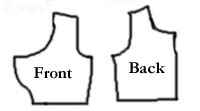 Here is the pattern as it was given to me. The bodice consists of four pieces, two in the front and two in the back. The back has a seam down the middle, as often shown in paintings, delineating the two back pieces. The armhole seems to come a bit further back on the shoulder blade, possibly to allow for a slightly larger range of motion. This may have been more fitted in the upper class version and slightly altered for the workers. The two front pieces are identical to each other. The most distinctive part of the front pattern piece is the curve for the bust at the lacing edge. This curve can be made greater or lesser depending on your endowment. This curve helps accommodate fit under the bust and at the bust without flattening or using extra gores.
Here is the pattern as it was given to me. The bodice consists of four pieces, two in the front and two in the back. The back has a seam down the middle, as often shown in paintings, delineating the two back pieces. The armhole seems to come a bit further back on the shoulder blade, possibly to allow for a slightly larger range of motion. This may have been more fitted in the upper class version and slightly altered for the workers. The two front pieces are identical to each other. The most distinctive part of the front pattern piece is the curve for the bust at the lacing edge. This curve can be made greater or lesser depending on your endowment. This curve helps accommodate fit under the bust and at the bust without flattening or using extra gores. 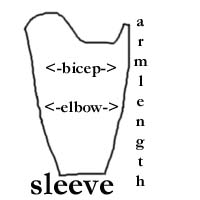 The sleeves have the seam at the back of the arm, which puts the forearm opening and buttons at the correct place, on the outside of the wrist and arm. You will want to line both the sleeves and the bodice for stability. The skirt is a basic rectangle pleated onto the waist of the bodice.
The sleeves have the seam at the back of the arm, which puts the forearm opening and buttons at the correct place, on the outside of the wrist and arm. You will want to line both the sleeves and the bodice for stability. The skirt is a basic rectangle pleated onto the waist of the bodice.
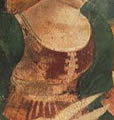
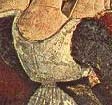
Construction tips and variations:
It is always wise to make up a mock version of any new pattern, often called a muslin. Please draw these patterns out to test on sturdy practice fabric. You can sew a folded over edge and sew yourself into the practice bodice to see if any adjustments need to be made. The following measurements correspond to the pattern pieces.
- Back of waist at last rib, from side to side across back, divided by 2 gives the back width measurement.
- Front of waist at last rib, from side to side across front, divided by 2 gives the front width measurement, at the bottom of the pattern piece.
- Nape of neck to waistline, as defined above, gives length of back seam at spine.
- Length of side from armpit to waistline, as defined above, gives the four side measurements, one on each bodice piece.
- Bust measurement from side to side across bust, divided by two gives the width of the front pieces at the curve.
- Measure across the topography from the last rib up to where you want the neckline to give you the length of the curve. Necklines varied from just above the bust line to above collarbone, so this is a personal preference.
- Measure around armhole and make sure that the armholes cut into pattern are at least that long, and can be slightly larger.
- Measure from base of neck at shoulder to the tip of shoulder for the strap width.
- From point of shoulder, across the elbow and down to the wrist gives sleeve length.
- Measure from point of shoulder to elbow to determine how much of the sleeve to sew closed.
- Measure around flexed bicep and add an inch or so for the width across the sleeve.
- Measure around wrist to determine the width of the sleeve at the end.
- Waistline circumference at the last rib, multiplied by anywhere from 3.5 to 5 will give you the skirt width to pleat onto waistline. Thickness of fabric can influence the amount of skirt you can pleat into the waistband.
- Measure from under bust to floor, add 2 inches for hem and possibly 6 inches for overlap.
The front was often laced up from the waistline to the neckline. Both lacing rings and worked eyelets appear to have been used on the front edges of the gown. The rings appear more often on upper class gowns, such at the Portrait of Ginevra de Benci by Leonardo da Vinci c.1474, or the Portrait of a Young Woman by Domenico Veneziano c.1465. Eyelet holes for lacing are clearly seen in the detail of the spinners and weavers in Cossa’s Allegory of March: Triumph of Minerva and in Madonna of Senigallia, c.1478. The lacing may stop at the waistline of the gown, but is also seen to extend into the skirt a foot or so. I have also seen buttoned front closures in Crivelli’s Madonna and Child Enthroned with a Donor, c.1470 as well as in Cossa’s Allegory of April: Triumph of Venus. These appear to be cloth or cloth covered buttons and they are not spaced closely like the lacing holes are. I would also hazard to guess that they are buttonholes instead of fastened through loops, because the buttons appear on the overlap of the front instead of just beside the edge.
![]()




The sleeves do seem to be mostly tightly fitted into the armhole and rarely allow the chemise to show through at the armhole. This could either be a laced-on sleeve with hidden laces (as was often used in the Elizabethan era) or sewn in to the armhole of the gown. Either way the one piece sleeves seem to have the seam at the back of the arm, starting out from the shoulder blade. The sleeves are left open from the elbow down to the wrist and closed together with a variety of methods. Some sleeves are closed with one button at the wrist. Some lace at the wrist in either four holes only (two on each side), or a small series of holes. I have also seen a trend to have them closed by one of the variety of methods at both the wrist and the middle of the forearm. The most common closure is with buttons, one at the wrist and one at the middle of the forearm. I imagine that one could also sew the sleeves closed temporarily, but they did not seem to do this often. Having the sleeve open from the elbow down does enable one to roll up the sleeves of the gown if needed.

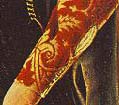
![]()

The skirt is always pleated to the bodice. I can’t imagine that the skirt would be separate, as the waistline is higher than natural and the skirt would slide. The skirt does have a front seam where the bodice closes, but is left open for 6-12 inches or more down from the waistline. This enables ease of getting in and out of the gown. Occasionally the lacing holes seem to extend into the skirt below the bodice to close this gap. This is not always the case however. The attachment methods of the skirts vary. Some skirts are regular knife or box pleats into the waistline like in Botticelli’s Portrait of a Young Woman, c.1475. The most common method seems to be some variation on cartridge pleating to obtain the finished look of regular rounded lines radiating from the waistline. The best examples of this are in Francesca’s Madonna of Senigallia and Cossa’s allegorical paintings of the months.
More to come on the underdress and overdress often matched with this gown. The underdress appears to be a variation on a t-tunic. The neckline is smooth when it shows out from the neckline of the gown and does not show evidence of gathers. The sleeves, while more full than the fitted over sleeves, appears to be a straight sleeve. It peaks out at the wrist and elbow, but not overflowing like a gathered "raglan" sleeve chemise.
The overdress appears to be less fitted and belted, much like a houpelande, with a variety of sleeves.
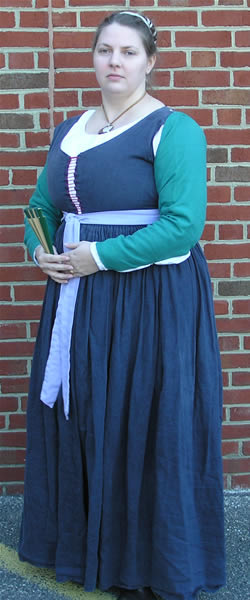 Photos ©2006 Drea Callicutt |
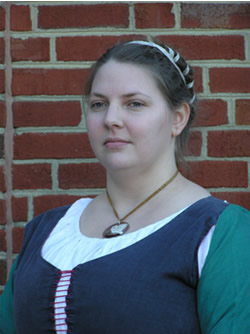 bodice is ladder laced to accomodate, ahem, expansion bodice is ladder laced to accomodate, ahem, expansion |
 sleeve is pinned on at the shoulder, closed at wrist and forearm with pewter buttons sleeve is pinned on at the shoulder, closed at wrist and forearm with pewter buttons |
|
|
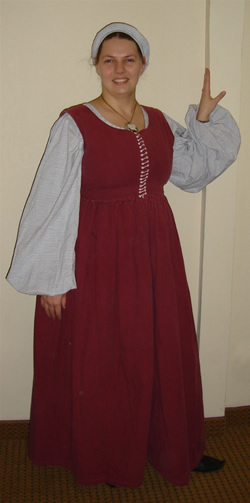 Red fustian Italian gown, originally constructed in 1999, shown here worn on 3/3/07. Worn without pinned on sleeves for warmer days. Photos ©2007 Jennifer Thies |
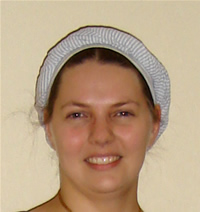 Turban or headrail, common working woman's head covering of the time. Keeps hair clean and out of the way. A simple 45" x 20" hemmed piece of cloth is secured at the nape with the narrow edge around the face. The rest of the length is twisted, wrapped around the head, and secured in back. |
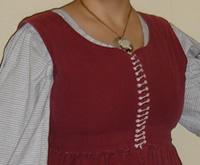 Spiral lacing closure with the diagonal advancing moves on the inside of the gown. Gives the effect of horizontal lacing lines, instead of the diagonal slashes seen in Northern European art. |
Paintings: all copies found at http://www.wga.hu/index.html
Attavante degli Attavanti, Missal, c.1485-87, Manuscript, Bibliothèque Royal Albert 1er, Brussels
Benozzo Gozzoli, Dance of the Salome, c. 1461-62, Tempera on panel, 23,8 x 34,3 cm, National Gallery of Art, Washington
Botticelli, Sandro, Venus and the Three Graces Presenting Gifts to a Young Woman, c. 1484, Fresco, 212 x 284 cm, Musée du Louvre, Paris
Botticelli , Sandro, Portrait of a Young Woman (La Bella Simonetta), c.1475, Panel, 61 x 41 cm, Galleria Palatina (Palazzo Pitti), Florence
Cossa, Francesco del, St Lucy (Griffoni Polyptych), c.1473, Oil on panel, 79 x 56 cm, National Gallery of Art, Washington
Cossa, Francesco del, Allegory of March: Triumph of Minerva, c.1476-84, Fresco, 500 x 320 cm, Palazzo Schifanoia, Ferrara (detail)
Cossa, Francesco del, Allegory of April: Triumph of Venus, c.1476-84, Fresco, 500 x 320 cm, Palazzo Schifanoia, Ferrara (detail)
Cossa, Francesco del, Allegory of May: Triumph of Apollo, c.1476-84, Fresco, 216 x 320 cm, Palazzo Schifanoia, Ferrara
Crivelli, Carlo, Madonna and Child Enthroned with a Donor, c.1470, Panel, National Gallery of Art, Washington
Leonardo da Vinci, Portrait of Ginevra de' Benci, c.1474-1476, Oil on wood, 42 x 37 cm, National Gallery of Art, Washington
Mainardi, Bastiano, Portrait of a Woman, ?, Tempera on wood, 44 x 33 cm, Staatliche Museen, Berlin
Piero della Francesca, Madonna del parto, c.1467, Detached fresco, 260 x 203 cm, Chapel of the cemetery, Monterchi (Arezzo)
Piero della Francesca, Madonna of Senigallia, c. early 1470s, Panel, 61 x 53,5 cm, Galleria Nazionale delle Marche, Urbino
Piero della Francesca, Adoration of the Holy Wood and the Meeting of Solomon and the Queen of Sheba, c. 1452, Fresco, 336 x 747 cm, San Francesco, Arezzo (left view) and (right view)
Pollaiuolo, Antonio del, Portrait of a Young Woman, c. 1465, Poplar panel, 52.5 x 36.2 cm, Staatliche Museen, Berlin
Pollaiuolo, Antonio del, Portrait of a Young Girl, ?, Museo Poldi Pezzoli, Milan
Tura, Cosmè, Annunciation, c.1469, Tempera on canvas, 349 x 305 cm, Museo del Duomo, Ferrara
Tura, Cosmè, The Spring, c.1460, Oil on wood, 116 x 71, National Gallery, London
Last updated on 10/20/2000
Pictures added on 3/8/2006
More Pictures added on 3/6/07
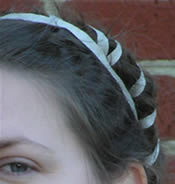 hair is braided and taped in place with tabby handwoven silk ribbon, slightly messy due to hurry and no mirror, but held fast all day with no bobby pins or hair spray
hair is braided and taped in place with tabby handwoven silk ribbon, slightly messy due to hurry and no mirror, but held fast all day with no bobby pins or hair spray